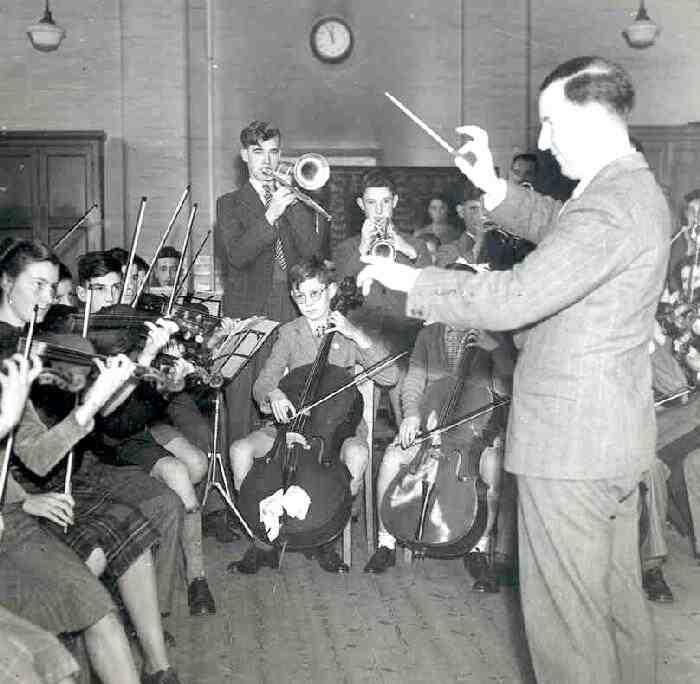
School Orchestras

Figure 1.--This English school orchestra was photographed we believe in 1948. We do not know the name of the school or the type of school, but it looks like a state school. There does not appear to be a school uniform which is unusual for England. While it looks like a school group, it could be a community group.
|
Schools varied as to whether they sponsored orchestras. A variety of factors were involved. Some schools focus on the academic program. Others give considerable attention to extracurricular activities. This approach to education varies from country to country as well as over time. Some schools are not large enough to have large orchestras, but many larger schools, especially secondary schools have them. Many of the boys and youth orchestras that we have noted are school orchestras. There are other types of orchestras, but quite a number are school orchestras. Another factor here is that primary schools are generally smaller than secondary schools, thus affecting the size of the orchestra that can be supported. Sime schools such as full term colleges (in the sence of combined primary and secondary school) often have orcestras. Private schools in general frequently support orchestras becuse they are well funded and almost all of the parents can afford music tuition. We have also noted sizeable orchestras at many state secondary schools.
Program
A Some schools focus on the academic program. Others give considerable attention to extracurricular activities. This approach to education varies from country to country as well as over time. American schools placed considerable emphasis on extracuricular activities. The activities varied from school to school. Sports and music was part of the program at virtually all schools. Other countries had schools that were almost entirely devoted to academics. The French and I think the Germans had schools with very strictly academic systems.
The populatity of school orchestras varied from county to country in part because of the different approaches to education in different countries. This is somewhat complicated by changing approaches to education in each country overtime. American schools have extensive extra-curricular activities while French schools tend to be more strictly academic. We note school orchestras in American and British schools as well as former British colonies which have generally followed British educational appropaches. We have little informtion about other European countries at this time.
Some schools are not large enough to have large orchestras. This was especially true of primary schools. Primary schools generally are relatively small. Smaller secndary schools also had trouble forming orchestras. Many larger schools, especially secondary schools, however, did have them. Often these were schools located in large cities. Some schools dealt with the size problem by creating a community orchestras out of student musicians from several schools. This was complicated by the transportation required. This is approach is often easy to tell because of the uniforms involved.
Many of the boys and youth orchestras that we have noted are secondary school orchestras. There are other types of orchestras, but quite a number are school orchestras. Another factor here is that primary schools are generally smaller than secondary schools, thus affecting the size of the orchestra that can be supported. Not only are primary schools small, but the younger children were not yet considered ready to participate in an orchestra. Opinios vary as to the age children should begin to play an instrument, but even children that have begun to master an instrument might not yet be ready to participate in an orchestra.Some schools such as full term colleges (in the sence of combined primary and secondary school) often have orcestras. A factor to consider here isthat except in America, access to secondary education was generally extremely limited until after World War II.Thus mos European children ended their education with primary school at about age 13-14 years. Secondary school was for the most part for children from well off families or the more academically capable children.
Private and State Schools
Private scgools in general frequently support orchestras becuse they are well funded and almost all of the parents can afford music tuition. We have also noted sizeable oechestras at many state secondary schools.
HBC

Related Chronolgy Pages in the Boys' Historical Web Site
[Main Chronology Page]
[The 1880s]
[The 1930s]
[The 1940s]
[The 1950s]
[The 1960s]
[The 1970s]
[The 1980s]
Navigate the Historic Boys' Clothing Web style pages:
[Kilts]
[Caps]
[Sailor suits]
[Sailor hats]
[School uniform]
[Scout uniforms]
Created: May 25, 2004
Last updated: 12:19 AM 7/15/2004



